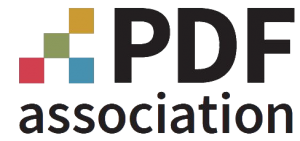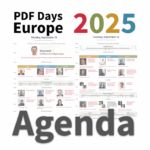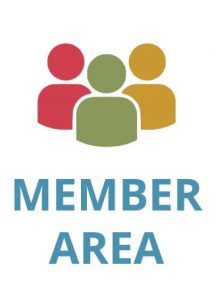Techniques for Accessible PDF – Background
These Techniques for Accessible PDF are developed by the PDF Association's PDF Accessibility Liaison Working Group.
Contents
Background
The Portable Document Format (PDF) allows for representing documents in a reliable manner independent of the software, hardware, and operating system used for the file’s creation or display. PDF’s specification was introduced and made freely available by Adobe Systems in 1993. In July 2008, PDF 1.7 became an ISO standard1. The latest version of the PDF specification, PDF 2.02, was most recently updated in 2020, and is now made available at no cost by the PDF Association.
Logical Structure and Tagged PDF
PDF provides an extensible mechanism for incorporating semantic and structural information about a document's content into a PDF file. PDF’s logical structure model is similar to that of semantic HTML in that the document’s structure is expressed as a hierarchy of structure elements, commonly known as "tags". These tags allow the PDF file’s creator to establish the semantic purpose (e.g., heading, paragraph, table, etc.) and logical ordering of content in a PDF document independent of appearance or layout.
Tagged PDF, defined in clause 14.8 of ISO 32000, is a use of PDF’s logical structure capabilities. Tagged PDF defines a set of standard tag types and attributes that allow page content (text, graphics, and images) to be characterized and ordered for extraction and reuse. Tagged PDF is used by software engaged in the following types of operations:
- Extraction of text and graphics for use by other applications (office software, search engines, etc).
- Reflow of text and other content for presentation on various types of devices.
- Conversion to other common file formats.
- Making content accessible to people who rely on assistive technology.
For technical information about PDF’s logical structure and tagged pdf features developers should refer to ISO 32000.
See this page for a list of tools that expose the relationship between tags and content.
PDF accessibility support
Accessible PDF depends on Tagged PDF.
PDF/UA (Universal Accessibility) is a specification defining the use of ISO 32000 to produce accessible PDF files. The first edition of PDF/UA became an ISO Standard in July 2012, and was updated in 20143. The 2nd edition of PDF/UA, ISO 14289-2, is based on PDF 2.0.
PDF/UA provides syntactical rules for creating accessible PDF files. The specification describes those PDF features that are required (or prohibited) for accessibility, and recommends the use of others. The means of achieving conformance with PDF/UA are left to the developer of PDF/UA creation software.
Conformance with PDF/UA therefore requires authors and remediators of PDF files to ensure that all information in a document is assigned an appropriate tag and is reachable in a correct sequence by means of the tag tree. See "Links to Resources" below for more information about these features.
About these Techniques
It’s important that users understand the intent and scope of these Techniques. In general terms, they are intended to provide practical examples of the various requirements of ISO 32000 and ISO 14289, mentioned above, as well as indicate some (not all!) of the ways in which these standards are commonly violated in PDF files that are not accessible.
These Techniques should not be taken to imply that every PDF file can be made fully accessible or can be adjusted to conform to PDF/UA requirements or to WCAG’s success criteria. Developers and users should always bear in mind the limitations of specific technologies and provide content in a way that is accessible to people with disabilities.
A fail case according to PDF/UA-1 may not always be a fail for WCAG, and would therefore be considered as an “advisory technique” in WCAG terms. Nevertheless, we list relevant WCAG success criteria even if they are not always a fail.
In cases where there is not a 1:1 relationship between PDF/UA-1 and WCAG requirements, we recommend conformance to PDF/UA-1.
What these Techniques are
These Techniques are informative and provide example PDF files, each demonstrating a single aspect of accessibility (for PASS cases) or inaccessibility (for FAIL cases), as well as test procedures to check compliance. These examples are “atomic” in the sense that they contain only the content necessary for demonstrating that specific aspect of the Technique. PASS cases conform to PDF/UA (ISO 14289) in all particulars, while FAIL cases intentionally do not.
What these Techniques are not
These Techniques do not provide instructions for the use of a certain software. They do not explain how to make accessible PDF files or remediate (apply corrections to) existing PDF files. Although the files are valid PDF files, they are merely atomic examples, and as such, are not “real-world” files.
Links to Resources
- ISO 32000-1, Document management — Portable document format— Part 1: PDF 1.7
- ISO 32000-2:2020, Document management — Portable document format— Part 2: PDF 2.0
- ISO 14289-1, Document management applications — Electronic document file format enhancement for accessibility — Part 1: Use of ISO 32000-1 (PDF/UA-1)
- ISO 14289-2, Document management applications — Electronic document file format enhancement for accessibility — Part 2: Use of ISO 32000-2 (PDF/UA-2)
- PDF Association publication: Understanding Techniques for Accessible PDF
- PDF Association publication: Glossary of accessibility terminology in PDF
- PDF Association publication: Matterhorn Protocol
- PDF Association publication: Tagged PDF Best Practice Guide: Syntax



